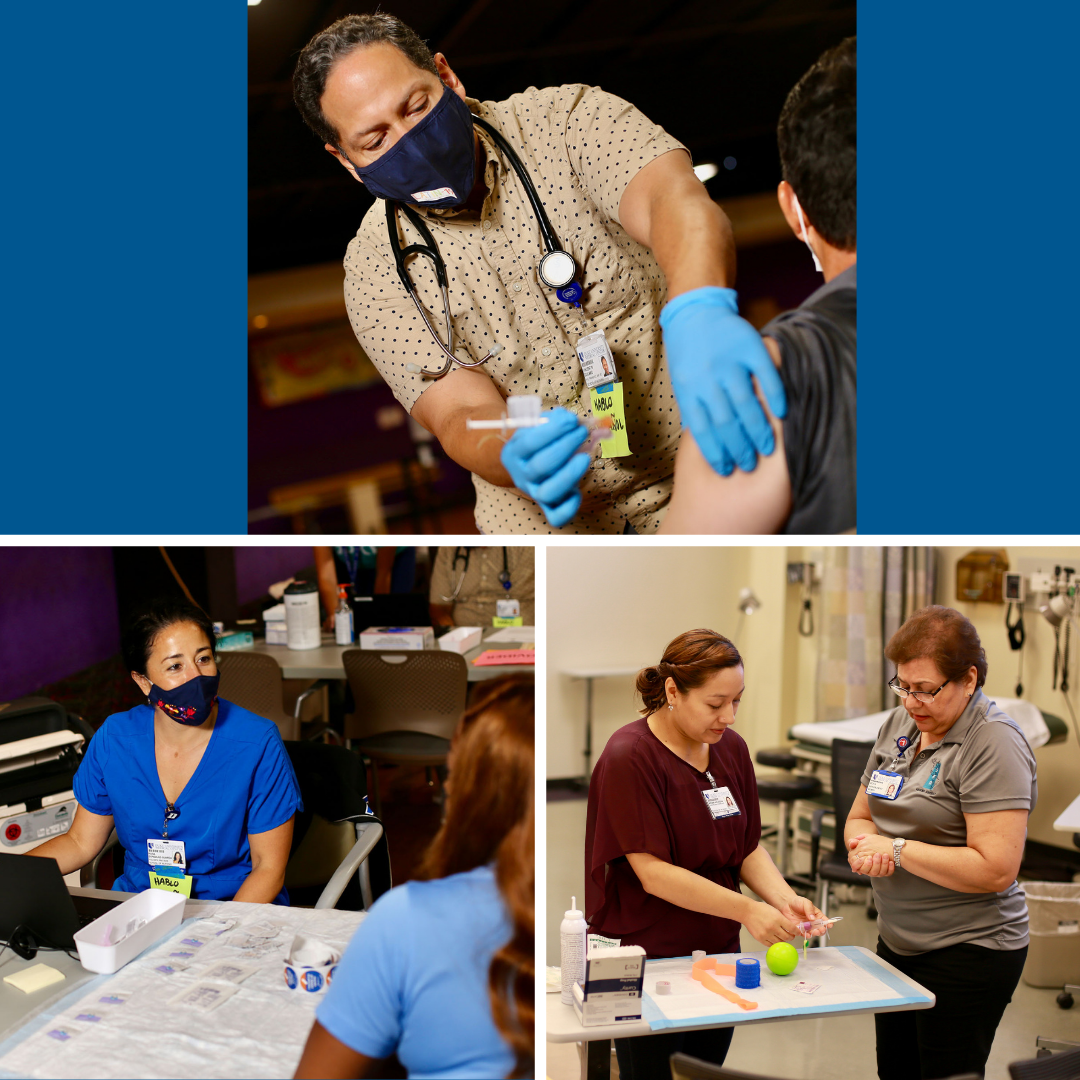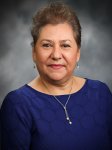The Latino U.S. Population is Growing. Is the U.S. Health Care System Ready?
More than 62 million Latinos live in the U.S. today. By 2060, that number is projected to approximately double. While the U.S. health care system has made strides in caring for this area of the population, much work is left to be done.

More than 62 million Latinos live in the U.S. today. By 2060, that number is projected to approximately double. While the U.S. health care system has made strides in caring for this area of the population, much work is left to be done.
 “It is possible to get the health care system to a place where it's responsive, but it's going to require a lot more investment than what we're investing right now,” said Rosa Gonzalez-Guarda, PhD, MPH, RN, CPH, FAAN, associate professor. “The health care system has been designed for the majority population, which has been a majority white population, so it hasn’t been designed for this projection. The system itself needs to be redesigned in partnership with the Latino community.”
“It is possible to get the health care system to a place where it's responsive, but it's going to require a lot more investment than what we're investing right now,” said Rosa Gonzalez-Guarda, PhD, MPH, RN, CPH, FAAN, associate professor. “The health care system has been designed for the majority population, which has been a majority white population, so it hasn’t been designed for this projection. The system itself needs to be redesigned in partnership with the Latino community.”
Redesigning the system can begin by assessing the infrastructure of the current workforce.
 “We need to put a lot more effort into educating the workforce and increasing the Latino representation in the workforce, so that there are people to care for the Latino people in institutions, and community health as well, who look like them, who they can relate to, and who have more of a say in how these programs and advocacy initiatives are set forth going forward,” said Irene Felsman, DNP, MPH, RN, C-GH, assistant professor. “Once that workforce is brought in, we need to then support them, so they feel comfortable and recognized within the institutions.”
“We need to put a lot more effort into educating the workforce and increasing the Latino representation in the workforce, so that there are people to care for the Latino people in institutions, and community health as well, who look like them, who they can relate to, and who have more of a say in how these programs and advocacy initiatives are set forth going forward,” said Irene Felsman, DNP, MPH, RN, C-GH, assistant professor. “Once that workforce is brought in, we need to then support them, so they feel comfortable and recognized within the institutions.”
Gonzalez-Guarda points out that a way to boost the amount of Latino health care professionals in the U.S. workforce is to have policies in place that would more easily validate the health care credentials and education immigrants earned in their native countries.
“It is such a loss potential of human capital that we're not leveraging, and our policies around the transfer of education and the lack of programs that can help this workforce integrate into the U.S. health care system is also a huge barrier,” she said.
Reworking current policies in general and adding new ones with the health care needs of the Latino population in mind should be another consideration moving forward.
 “From an immigration policy perspective, ensuring that we have inclusive policies would lessen fear of seeking health care and the repercussions of that,” said Allison Stafford, PhD, RN, assistant professor.
“From an immigration policy perspective, ensuring that we have inclusive policies would lessen fear of seeking health care and the repercussions of that,” said Allison Stafford, PhD, RN, assistant professor.
Health care professionals can be trained to better connect with their Latino patients. One method is by encouraging professionals to take Spanish courses in order to learn, at minimum, basic communication skills and gain some cultural competency. The Duke University School of Nursing, for example, offers a medical Spanish elective for all its students.
 “We should include more language capacity and cultural competency so, not just having bilingual, bicultural native speakers in the workforce, but also to have more training for our students, including medical students, nurses and health professionals,” said Rosa Solorzano, MD, MPH, consulting associate. “If we can broaden our elective so that everybody has access to it, more students can have tools to thrive and meet the needs of Latino patients.”
“We should include more language capacity and cultural competency so, not just having bilingual, bicultural native speakers in the workforce, but also to have more training for our students, including medical students, nurses and health professionals,” said Rosa Solorzano, MD, MPH, consulting associate. “If we can broaden our elective so that everybody has access to it, more students can have tools to thrive and meet the needs of Latino patients.”
When people turn to health care professionals for help, they often seek a humanistic, personable approach and rapport.
 “Creating healthier relationships between patients and health care workers is important in terms of building trust and autonomy while also educating the patient so that they have this autonomy,” said Maralis B. Mercado Emerson, clinical research coordinator. “They, as patients, can make very educated decisions, but on the flip side, there's a due diligence of helping educate the patient on what all the options are.”
“Creating healthier relationships between patients and health care workers is important in terms of building trust and autonomy while also educating the patient so that they have this autonomy,” said Maralis B. Mercado Emerson, clinical research coordinator. “They, as patients, can make very educated decisions, but on the flip side, there's a due diligence of helping educate the patient on what all the options are.”
Educating health care professionals on the proper way to support their Latino patients can start while they are still earning their degrees, as the Duke School of Nursing demonstrates.
“We have had the wonderful opportunity to work with ABSN and PhD students in the research that we conduct,” Emerson said. “They're not just cleaning data or behind the scenes, but they have been forward facing on our projects. We still get emails and text messages from those students that have graduated, saying how valuable these kinds of opportunities are.”
One main ongoing research study project with which students have been involved is the SER (Salud, Estrés y Resiliencia/Health, Stress and Resilience) Hispano Project. This research study, funded by the National Institute on Minority Health and Health Disparities, evaluates how acculturation stress has impacted the health and wellbeing of local Latino immigrants.
The pandemic has been an enlightening time in gathering information for the project.
“Our team has really leveraged what we did this past year,” Gonzalez-Guarda said. “We were able to work with community health workers that were doing COVID-19 prevention and response to develop and test a program to address acculturation stress and promote resilience during the pandemic.”
Data collection for SER Hispano will conclude in January, at which point the team will be focused on muilti-level interventions to address acculturation stress and resilience, key drivers of health in this population.
Interfacing directly with the Latino community is also valuable experience for students. The School of Nursing takes several approaches to involve students in community outreach and interaction with the Latino population, both locally and aboard.
The Accelerated Bachelor of Science in Nursing (ABSN) program, for example, includes a Community and Public Health Nursing course.
“We have several groups of students who work with various community groups like El Centro, Immaculate Conception Catholic Church’s Latino outreach program, and with the Mexican Consulate, the Ventanilla de la Salud program, which is a window for health project, so our students that speak Spanish or even have some level of Spanish will be placed in those community areas to work with the population for over a 12-week period twice a year,” Felsman said.
Duke nursing students can also join organizations such as the Duke Nursing Students Without Borders Club. The club’s mission is to promote health empowerment through participating in volunteer efforts in education and hands-on patient care, building networks to access health care resources and distributing collected materials to local, regional and international communities.
“We have quite a lot of needs in our own country around the Latino community,” Felsman said. “Ideas that have come up for the future include looking at getting involved with certain programs, such as working on the border of Mexico and with farmworkers projects in the rural areas of North Carolina.”
The School of Nursing’s faculty and staff have worked with the Latino community in various capacities.
 Vincent Guilamo-Ramos, PhD, MPH, LCSW, RN, ANP-BC, PMHNP-BC, AAHIVS, FAAN, dean, School of Nursing, and vice chancellor for nursing affairs, Duke University, founded and directs the School of Nursing’s new The Center for Latino Adolescent and Family Health (CLAFH). The Center’s mission is to reduce health inequities and promote overall wellbeing among Latino adolescents and their families. It develops, evaluates and disseminates family-based interventions and nurse-driven models of health care delivery designed to address the social determinants of health, reduce health disparities, increase Latino engagement in health care and promote life opportunities.
Vincent Guilamo-Ramos, PhD, MPH, LCSW, RN, ANP-BC, PMHNP-BC, AAHIVS, FAAN, dean, School of Nursing, and vice chancellor for nursing affairs, Duke University, founded and directs the School of Nursing’s new The Center for Latino Adolescent and Family Health (CLAFH). The Center’s mission is to reduce health inequities and promote overall wellbeing among Latino adolescents and their families. It develops, evaluates and disseminates family-based interventions and nurse-driven models of health care delivery designed to address the social determinants of health, reduce health disparities, increase Latino engagement in health care and promote life opportunities.
Another outreach effort, with which some faculty and staff members are involved, started in response to the COVID-19 pandemic — the Latinx Advocacy Team & Interdisciplinary Network for COVID-19 (LATIN-19) coalition. More than 500 participants comprise the coalition, coming from academic institutions, public health departments, public school systems, community-based organizations, government, faith communities and more.
The coalition has worked to provide COVID resources in Spanish, add more testing and vaccination sites to places that are more accessible to the local Latino community and advocate for such regulations such as not requiring identification at vaccination events.
“Within the coalition, it feels like there's a space for everyone to share what's going well and to voice their concerns, and those concerns are heard,” Stafford said. “Some of the meetings are just an open time for community health workers to share what's happening. I think we’re going to see the fruits of this coalition for years to come.”
LATIN-19 hosts open weekly meetings. To register, visit its website.
“The pandemic taught us there is a lot of things that we can do universally in order to tweak the health care system,” Solorzano said. “We should take some of those lessons to move forward and shape the health care in the United States.”